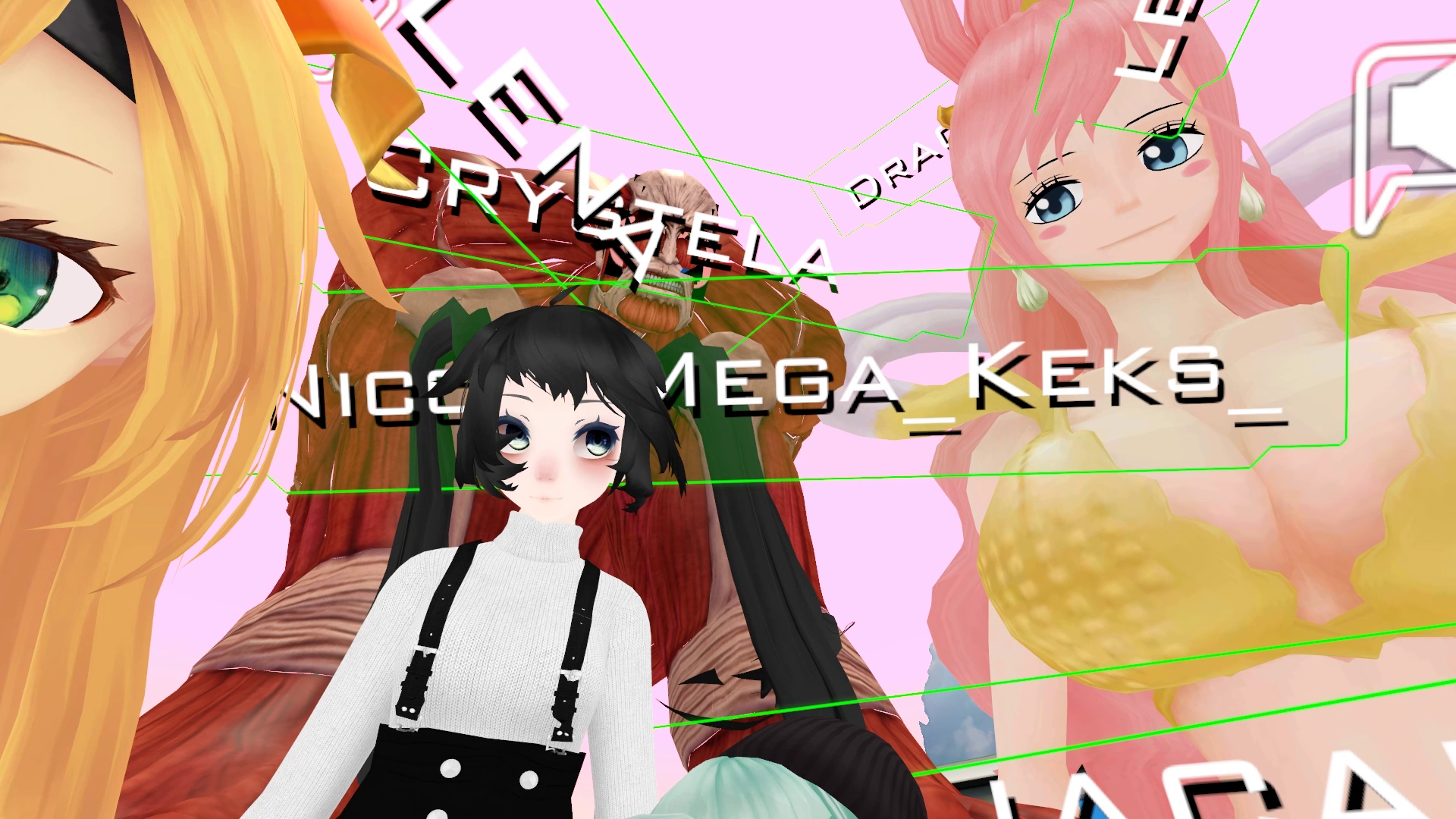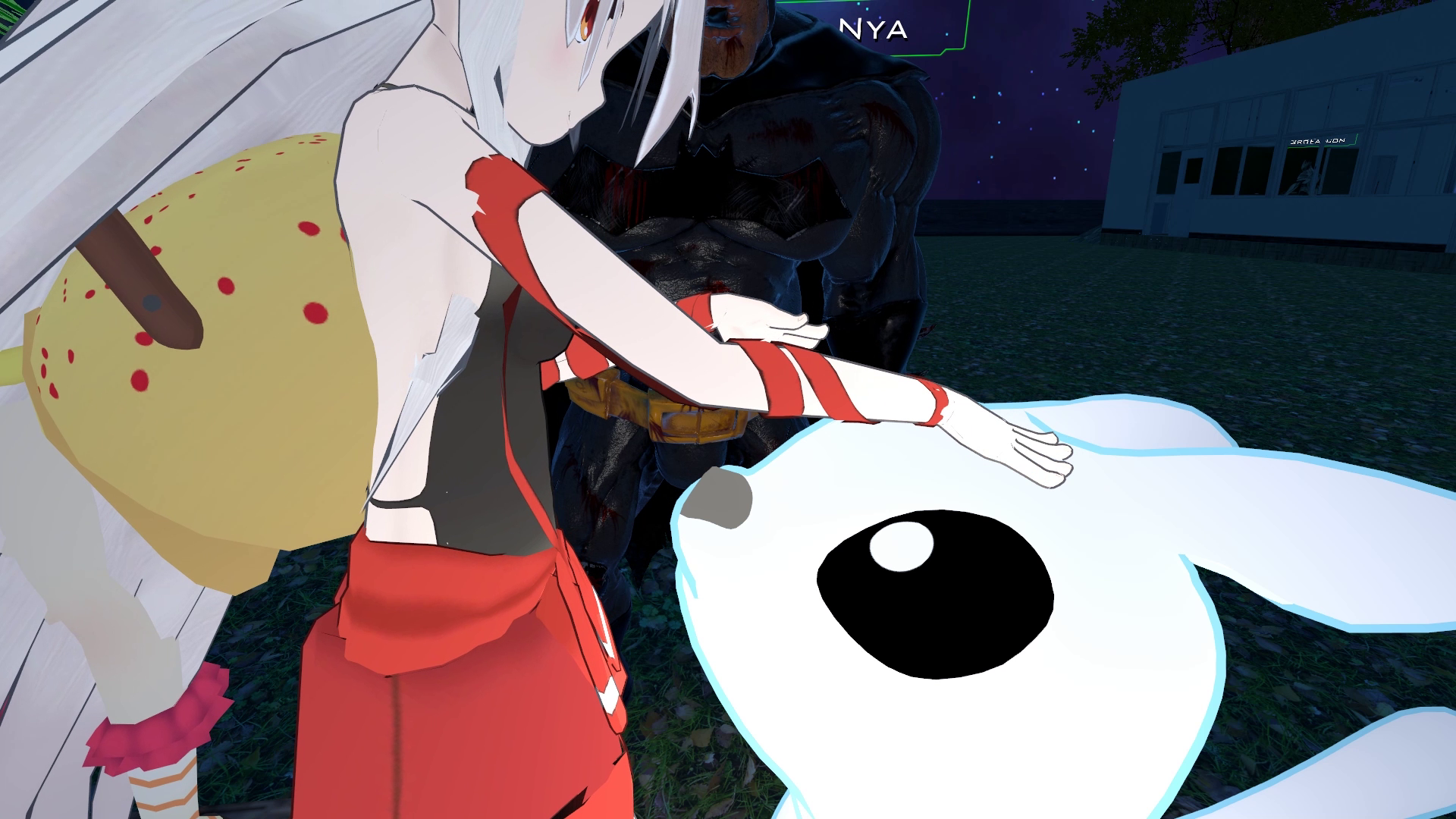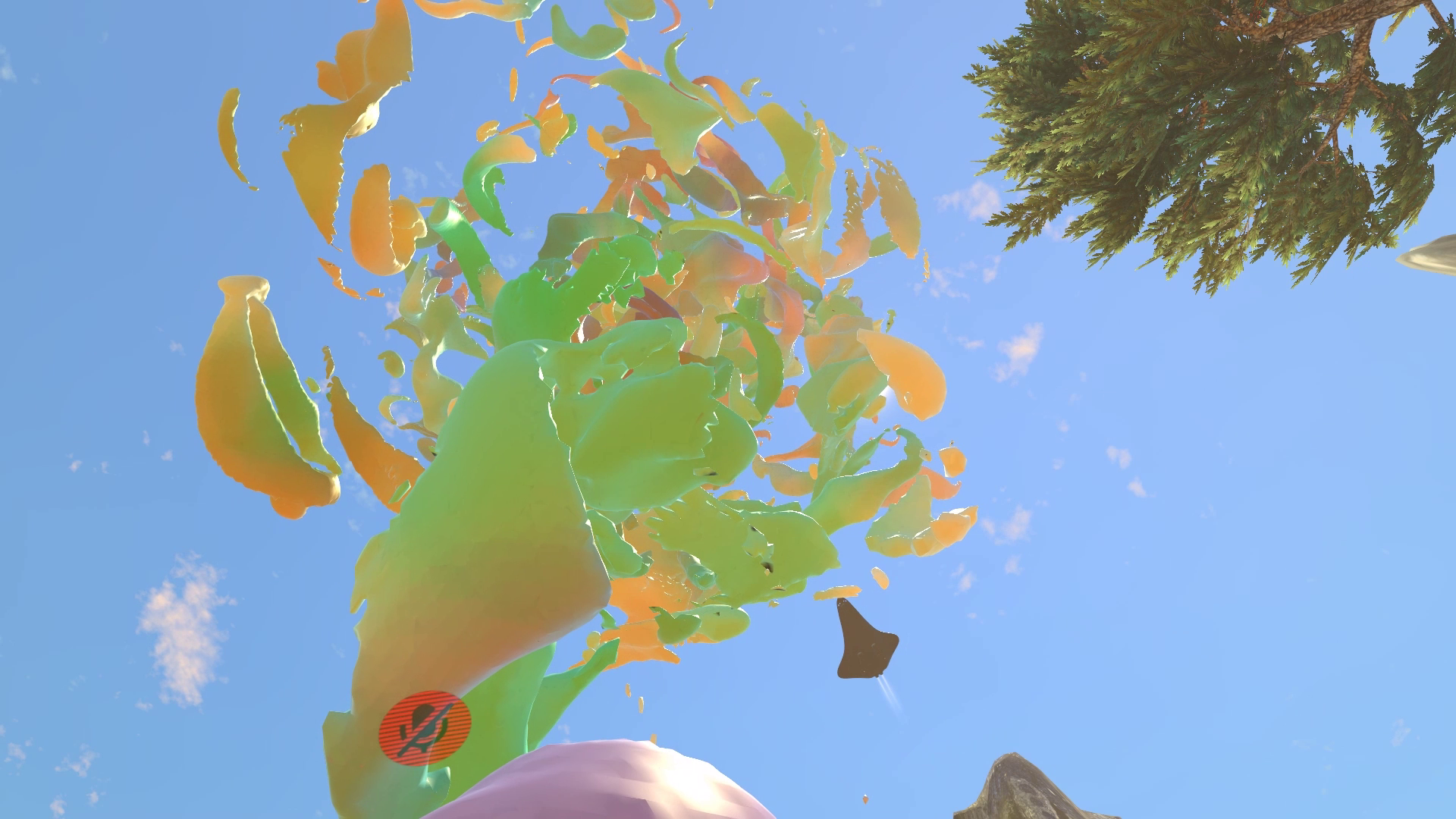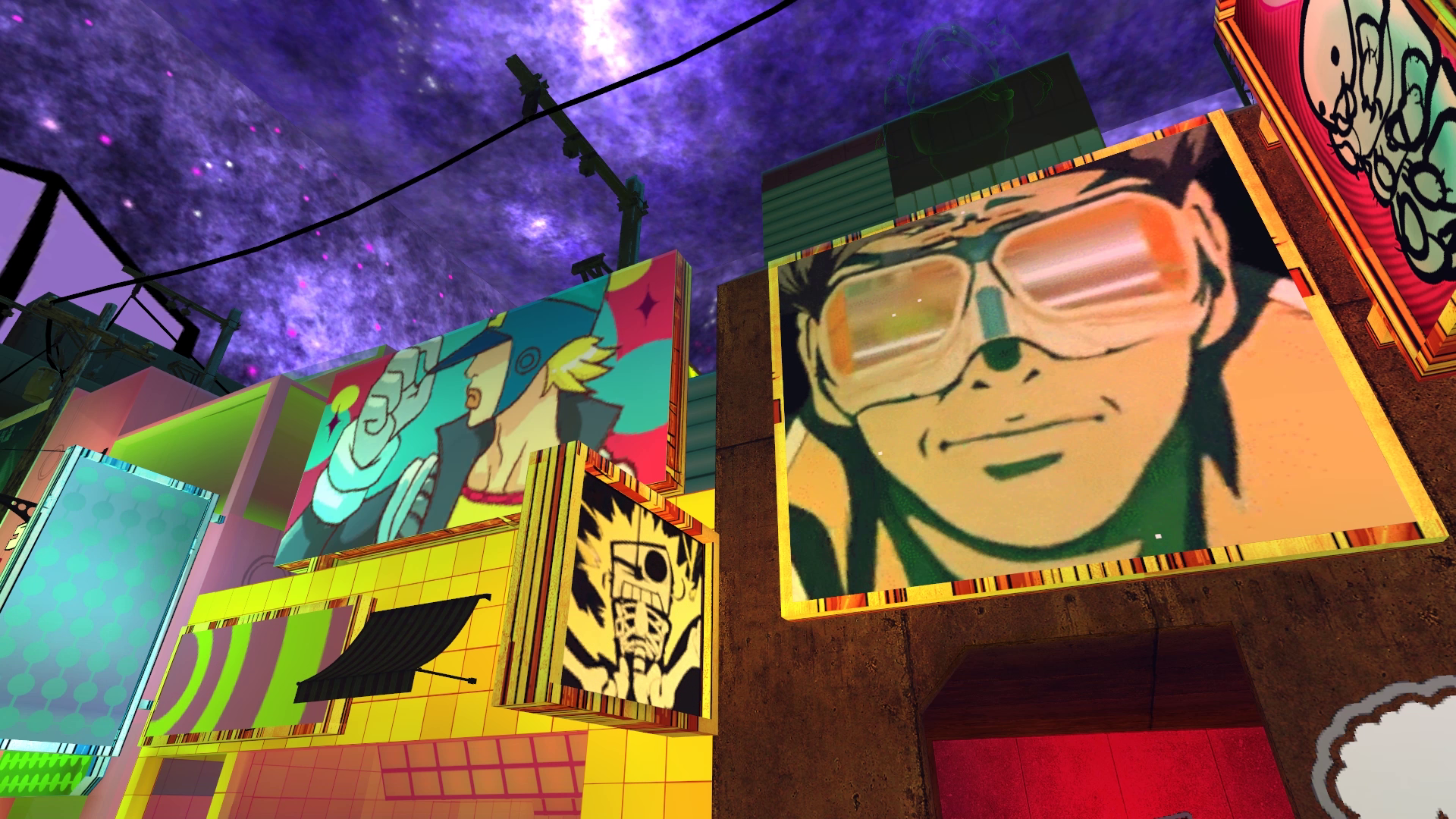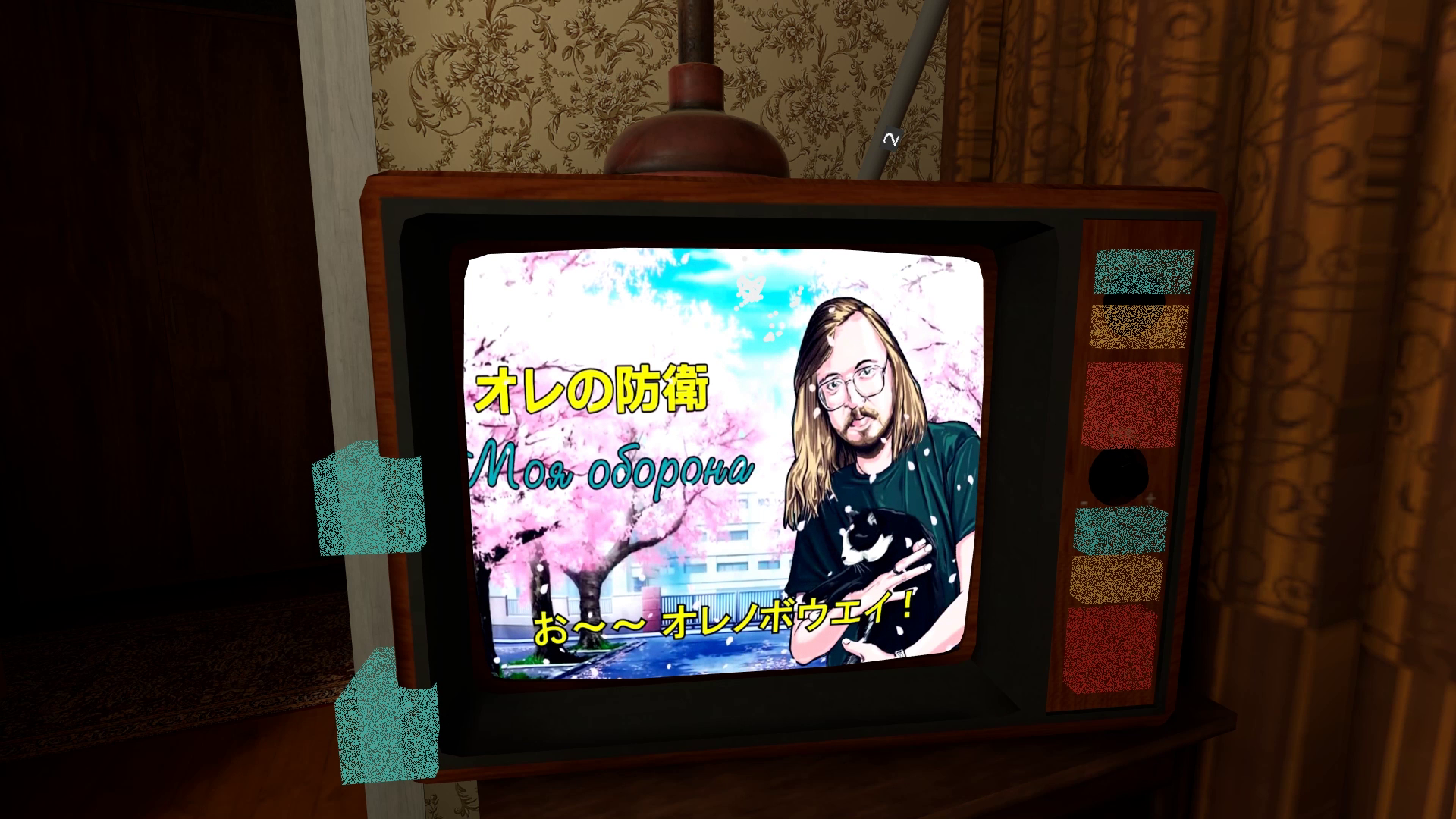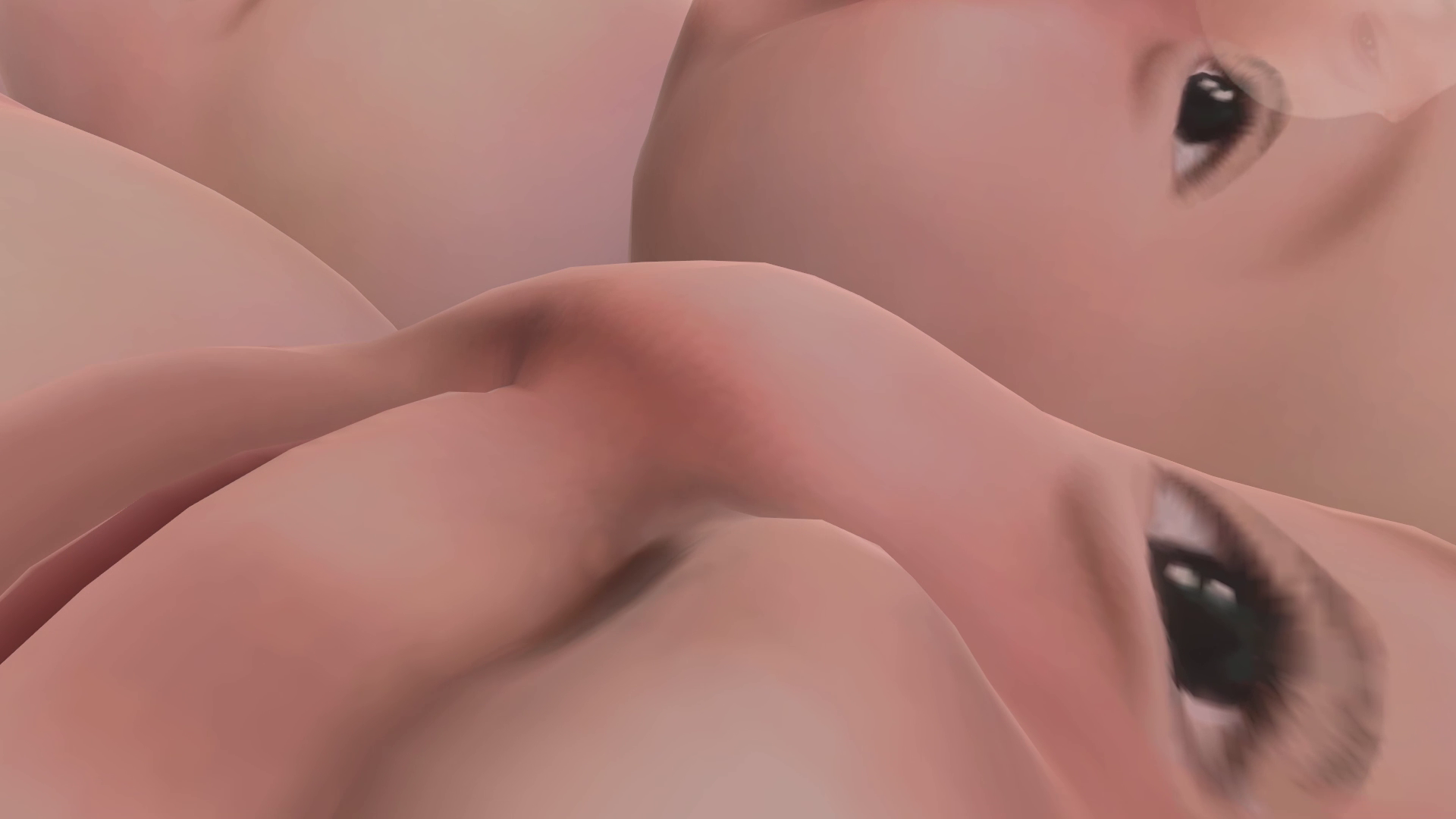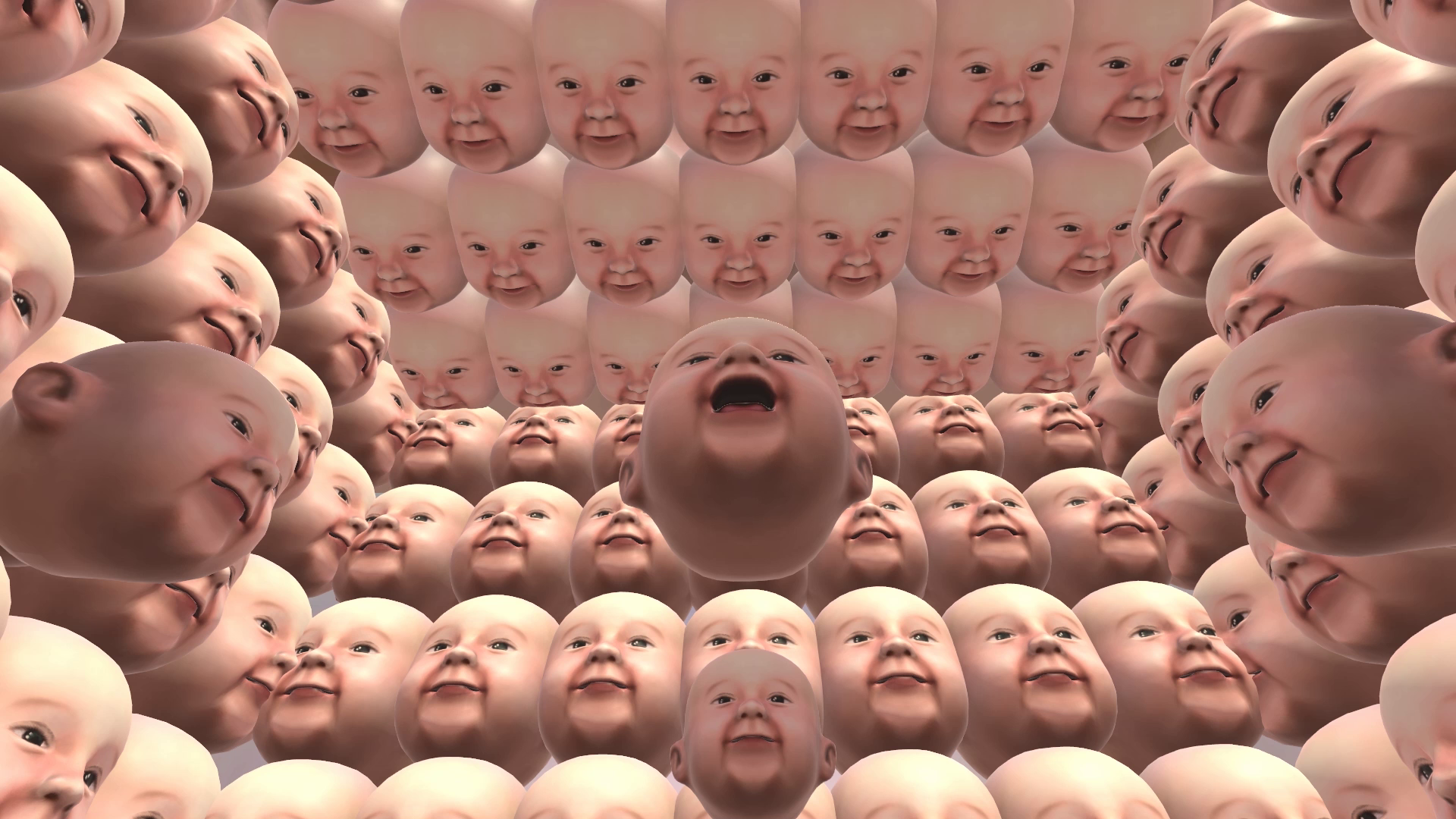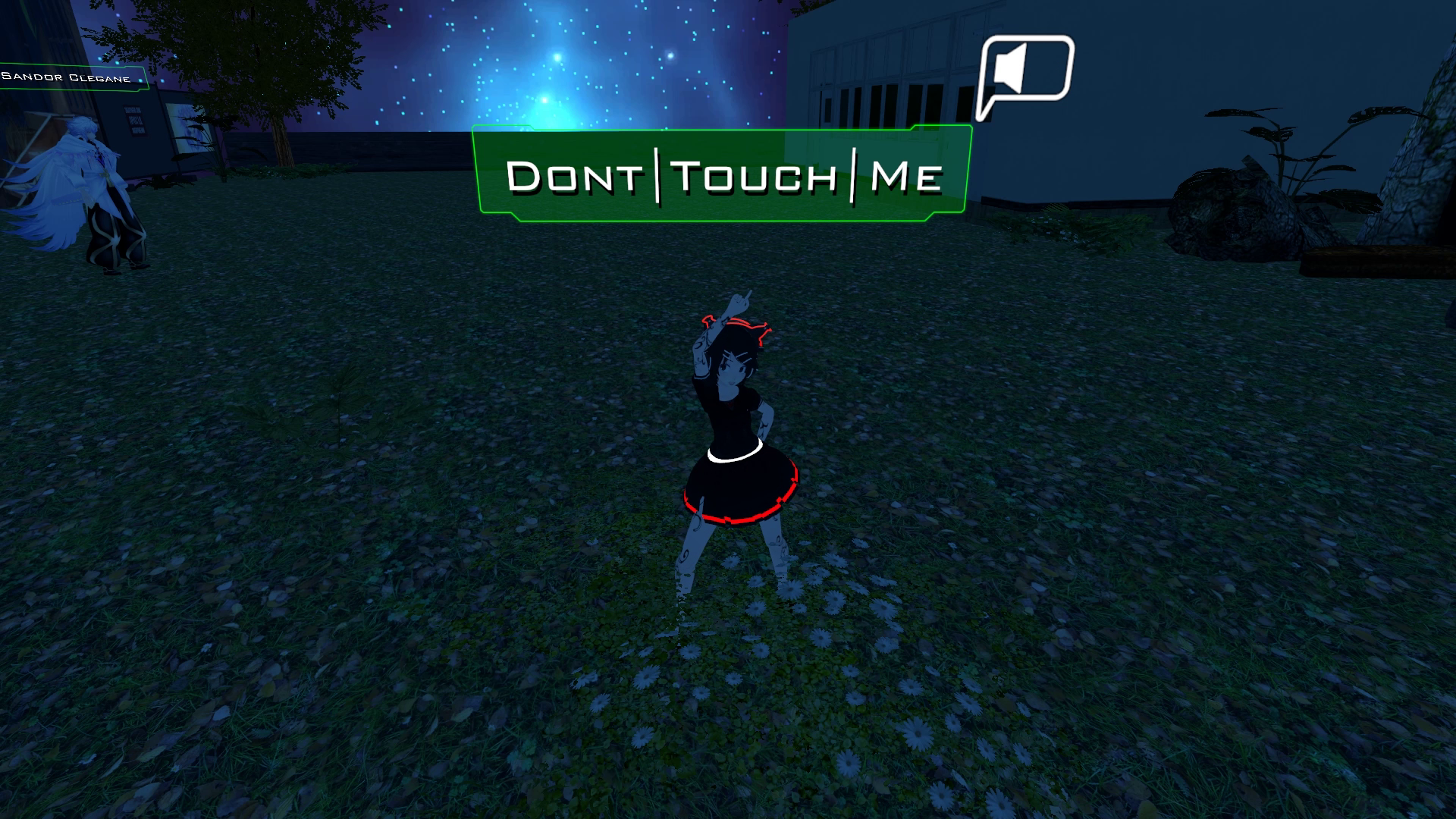Forward, upward, in all directions
digital video (1980 x 1080), color, sound, 19’ 16”, 2018, Ukraine
Created by fantastic little splash
At once poetic and prosaic, Forward, upward, in all directions is a psychedelic trip inside VRChat, a free-to-play massively multiplayer online virtual reality environment created by Graham Gaylor and Jesse Joudrey. Introduced in early 2017, VRChat has gained popularity in the last few years thanks to the incessant activities of live streamers. Evocative of virtual worlds of the early Zeroes like Second Life but enhanced by virtual reality immersion, VRChat has now spawned several paratexts, including a weekly online newspaper, talk shows, and podcasts. Players create their own avatars based on popular characters from video games, television, anime and movies and hang out online. Fantastic little splash’s Forward, upward, in all directions documents a neo-tribal global village connected by technology, focusing on the rites and rituals of a growing subculture.
Fantastic little splash is a collective comprising journalist, filmmaker and visual artist Lera Malchenko and artist and director Oleksandr Hants, whose artistic practice examines the nature and flow of information: its generation, distribution and transmutation. Fantastic little splash is especially interested in digital collective practices, alternate realities, order and entropy, utopias and dystopias. Their work is situated at the crossroads of media studies, architecture, and anthropology. Established in 2016, their projects have been exhibited at The Wrong biennale, post.MoMA, Construction festival VI x CYNETART, Revelation Perth International Film Festival, and Pineapple underground Film Festival among others. Fantastic little splash is based in Dnipro city, Ukraine.
Matteo Bittanti: Both your background and artistic practice are heterogeneous as they involve different media, tools, and aesthetics. Can you briefly describe your modus operandi? I am also very interested in your approach. How do you choose a specific medium – for instance 3D animation or machinima – to investigate a topic?
fantastic little splash: Our collective combines art practice with media research. The group has two members: Lera Malchenko, a journalist and filmmaker and Oleksandr Hants, an artist and filmmaker. Our backgrounds define both the tools we use and, in many ways, the topics. Lera previously worked with text and, more often, with video. Oleksandr uses 3D graphics and video, so we often turn to these tools. Moreover, our location is an important factor in relation to our practice: Ukraine is a post-Soviet young state. In Soviet times, the Ukrainian information space was distorted by Soviet ideology. When the country experienced a communist hangover following the collapse of the Soviet Union, social media suddenly became pervasive. Ideologies and social media produce similar effects: they construct limited realities, and thus, deliberately limit people’s perception. This is how a hybrid of these modes of perception was formed in Ukraine. As a result, a very fickle, sometimes dangerous, but always interesting – at least from an artistic and research point of view – information space emerged in the past decade or so. We are very interested in exploring such space.
The media we choose is often influenced by the topic we are investigating. When we were filming in VRChat, we did not know much about machinima, so in this case, everything was done intuitively. We were not focusing on machinima as a genre or style: the process we applied to make Forward. upward, in all directions was not much different from shooting in “real” environments. Filmmaking for us is more like an exploration, a way of noticing things that may otherwise be overlooked, than the making of a traditional artwork, which is usually conceived as a vessel for expressing ideas through the conventions of a specific genre. In short, we were mostly unaware of what we were looking for when we began Forward. upward, in all directions.
Matteo Bittanti: Your process reminds me of McLuhan’s concept of probing, a process of experimentation, discovering, unveiling... I would love to know more about the creation of Forward, upward, in all directions. How long did the process take, from conception to execution? How much did you spend online collecting the footage? And is the footage included in the final cut entirely from VRChat or did you add extraneous content? I’m really intrigued by the floating baby heads at 12’ 50”, for instance. Did you encounter them in VRChat?
fantastic little splash: We’d like to clarify that we conducted this study when VRChat was in its infancy. Initially, VRChat did not have moderators. Most of the moderation tools were added much later. We are talking about early 2018. We were looking for a multiplayer game to explore and we came across an article about VRChat, which featured quirky and trippy screenshots, so we decided to give it a try. We were very lucky to witness the emergence of this platform before its popularity reached a peak. We were totally fascinated by VRChat. When we first discovered it, it was all we could think and talk about. Shortly after entering this space, we began an art residency in our hometown of Dnipro titled Construction Festival. The final exhibition was called Reality and we continued the work we began in VRChat within this context. Overall, er spent about three months there. Everything you see in Forward, upward, in all directions was filmed inside this virtual world. We did not use any additional source, although at first we contemplated this idea. We shot in VRChat daily. We even dreamt about VRChat during the production. It was an interesting experience, very oneiric, which became important for our subsequent research.
Matteo Bittanti: The ongoing pandemic and lockdown measures made online interaction more popular than ever. From Zoom to Fortnite, from endless virtual chats to Animal Crossing, people are spending more and more time indoors, glued onto their screens. Do you think that Wim Wenders was correct by depicting a society obsessed with screen-based entertainment even in the face of a looming apocalypse in his 1991 film Until The End of the World? Is the current fascination for virtual reality and simulated worlds just another form of escapism, or do you see something more sinister?
fantastic little splash: No, we do not think that VRChat, or any other virtual world or computer games for that matter, is a mere form of escapism. It is a medium, just like a book or a movie, but much more immersive. Compared to existing media, VRChat introduces a deeper form of communication, because it is highly interactive. Wim Winders’s Until The End of the World is truly catastrophic. Wenders is one of our favorite filmmakers, by the way. Perhaps, this is a natural reaction to the state of global “decay” we are experiencing today, the end of a linear history. It feels scary and unbearable. Our new video essay Similar image – which we are producing as we speak – focuses on this kind of anxiety. In a sense, VRChat was prefigured by another German director, Werner Herzog. In fact, VRChat is the answer to his question “Does the Internet Dream About Itself?”, which he posed in his 2016 documentary Lo and Behold: Reveries of the Connected World. We do believe that the solution to the puzzle is a resounding yes. Digital folklore is part of the internet’s dreamworld. VRChat is very similar to a dream, sometimes hectic and erratic, sometimes calm and idyllic, always very unpredictable.
Matteo Bittanti: Forward, upward, in all directions is incredibly funny. It looks – and sounds – like a deranged luna park. At the same time, it’s impossible not to notice “ironic” references to nazism and Aldolf Hitler, among other things. Since video game spaces have been traditionally associated with the far right and libertarian ideologies, do you see any risks that anti-democratic forces are colonizing the digital imaginary? Where does the VRChat community stand, politically? fantastic little splash: When we were filming inside VRChat, we could not identify one or more dominant political positions. On the contrary, several different views were on display, often presented in an extremely ironic manner. In a sense, all political statements that we encountered were framed as parody, or at least that’s what they looked to us. In most cases, it was all very playful and lighthearted. The most radical political statement that went beyond this space was a kind of “game terrorism”. The “Slavic world” map, created primarily by Russian users for other Russian users, was visited by Ukrainian players. They created avatars with highly complex animations which were very taxing on other users’ GPUs. They used a huge number of particles depicting hundreds of small Ukrainian flags. When they were running this animation, most of the players’ video cards could not process such a huge amount of data, and players were basically thrown out of the game.
Early VRChat was almost an àgora of the internet. Although there were no moderators and almost no blocking tools, players fought against, let’s say, Knuckles, by negotiating with each other. If someone heard or noticed that one of the players was behaving abusively, in a relatively small map, he or she would immediately inform all the other players. You could not mute troll for other players: each player had to do it by herself or himself. In other words, the agent provocateur was marginalized and since there was almost nothing that he or she could do in that map, there was no other choice but to leave. In other words, the players themselves were forced to develop self-regulation tools instead of relying on the ubiquitous moderator. In a sense, it is much more effective to get multiple “mutes” from ordinary users than a one-time super-ban from a single moderator. We felt very encouraged by the human potential in fighting anti-humanist behavior in online spaces. Mutual agreement was reached in VRChat without the need of a top-down decision. We witnessed a self-regulating, decentralized community.
Matteo Bittanti: In your artist statement, you quote Marshall McLuhan’s notion of retribalism as one of the outcomes of the electric age. According to the Canadian scholar, the emergence of new media in the 1960s led to a resurgence of a new kind of tribalism. One manifestation was the so-called global village, an interconnected meta-space where everybody was closely linked to one another. But one side effect of this new configuration was that tensions and friction would inevitably increase. In fact, McLuhan predicted that violence in society would increase: the global village, he said, is not a peaceful place. Today, the global village is on fire, both literally and metaphorically. Technology did not prove to be a very effective instrument of social cohesion, on the contrary it has led to chaos, disinformation, and polarization. Was his diagnosis correct? If so, what role can artists play in such a volatile environment?
fantastic little splash: We think that the growth of violence and friction is probably the first effect of the opening up of previous closed societies and cultures. We also believe that such an issue can be overcome painlessly. To achieve this goal, we need to come to an agreement, and it is not always possible to come to an agreement without this first initial clash between different parties. As a model of social dynamics, VRChat replicated these processes. In fact, we were able to identify the approximate algorithm for the behavior of players entering VRChat. At first, many try to “play out” existing cultural situations, often in very extreme forms or by reenacting historical antagonisms between, let’s say, Americans and Russians. Many DIY-maps in VRChat have a national character, and people from certain cultures tend to hang out in places that are culturally homogeneous. VRChat also exemplifies the confrontation that often arises when a member of a specific filter bubble encounters a member of a different filter bubble. In our highly polarized world, different points of views reflect different world views. As we grow accustomed to sheltering ourselves in social media spaces that reflect our own values and beliefs, it can be shocking to realize that not all online environments follow the rules of, let’s say Facebook. In early VRChat, there were no such bubbles or algorithmic-based safe spaces, so that your world consists only of your acquaintance, friends, and people with similar interests or mindsets. Thus confrontations were incredibly frequent. Perhaps we are now incapable of facing unmoderated communication. Thus, players either follow their familiar cultural patterns or abandon them. It seems that the most interesting thing is happening at this very moment within VRChat. Players have begun to look for a common language with members of a different culture, and we are not talking about English. Often, these trends are collective and spontaneous. Specific behaviors that were unique to VRChat migrated to other contexts, but only those who are familiar with the idiosyncrasies of this space can recognize them. We are talking about dance routines, looping meaningless gestures, all of which are about emotion and interaction. These players perform breathtaking spectacles and we tried to document the variety of behaviors that we encountered. This openness – the willingness to be surprised and to notice without judging – is the task of the artist. The artist is a sensitive observer who is able to capture these moments. The artist can convey and share the magic of emergent, non-violent interactions.
Matteo Bittanti: The so-called “virtual” and the equally porous “reality” are not mutually exclusive. These ontological categories must be understood as a continuum rather than a dichotomy. These days, we have become cyborgs: it’s hard to tell where the hand ends and the smartphone begins. As McLuhan predicted, these appendixes are now fully fledged organs. Media extend, augment – sometimes numb – our senses. Interestingly, however, VR displays remain a niche affair. The medium which aspires to erase itself in order to deliver full immediacy, as Richard Grusin wrote in his seminal book on premediation, has so far struggled to enter the mainstream. Do you expect that this situation will change in the foreseeable future? Can the repeated failure of VR to become a mass medium be explained with technological, cultural, and/or political factors? What is your take on the relationship between art and VR?
fantastic little splash: We think VR is not that popular in the first place because of technological limitations: it is still a bulky device. Also, it is not very cheap. Moreover, it is still too narrowly focused. For example, while your smartphone can perform several functions, existing VR technologies have not yet become multifunctional. We also think that the future of VR is inextricably linked with AR. Perhaps the two will somehow merge with the aid of glasses rather than head mounted displays. This hybrid technology could in fact replace smartphones and become a new extension of the human body.
At the same time, we should not forget that these technologies were originally developed by the military. Media studies remind us that VR and AR were invented for purposes that are far from peaceful. Even today, they remain technologies of war, like weapons: not necessarily for physical war, but certainly for a new, hybrid, informational warfare. In fact, these technologies can replace human beings in the management and deployment of weapons of mass destruction. Slavoj Žižek wrote a remarkable essay about the underlying ideology of Pokémon Go. He argues that Pokémon Go and augmented reality in general operate as most ideologies, that is, they superimpose a specific interpretation or narrative onto the real. We can therefore imagine different kinds of software and uses for these devices, for instance ad hoc AR glasses for people who must engage with a particular kind of information or operate in a particular context. However, we know that the dissemination of disinformation and doctored information is extremely damaging, as it can lead to radicalization and real-life violence. In fact, this is the default mode of both mass media and social media. If we add VR and AR to this already problematic state of affairs, it is clear that the media can further destabilize and manipulate the users. We think that the role of the artist is to counter these militaristic and nihilistic tendencies, which are particularly manifest within internet culture and digital technology today. Like any highly-immersive technology, VR and AR also can be used to democratize and unite users, bringing out our best features, and to intensify our interactions, by stimulating our feelings rather than our most vile attitudes.
Matteo Bittanti: According to McLuhan, the media can recalibrate our sensorium. VRChat promises to connect users thanks to its unprecedented level of intimacy, and yet touch is still a mirage, no matter how sophisticated haptic interfaces have become nowadays. In an era when the body of the Other has become threatening – she or he could be a carrier and spread the contagion or worse, she or he could carry corrupted ideas – can technology somehow bridge the corporeal gap or, as a medium, i.e. something that stands between things, can only make things worse and increase the distance?
fantastic little splash: It’s really up to us to use technology for purposes of good or evil. We can use the internet to ignite a revolution and defend our rights, support each other or, on the contrary, distribute hateful content that can emotionally damage others, destroy their trust and smash their hopes. It is critically important today to understand that in order for us to continue to exercise this crucial right to choose, we must pay more attention to the black box problem. If we abdicate our agency for convenience and renounce the ownership of our precious data a priori, we set ourselves on a dangerous path. By delegating to huge corporations the management of our digital lives, we deprive ourselves of the right to choose a future for our society. If we do not understand the logic of the algorithms that inform our increasingly digital lives, we put ourselves at their mercy. Technology is often described as a magic power. But its inner workings are deliberately rendered opaque by their makers and administrators. On the one hand, devices are more intuitive than ever. Interfaces are more and more user friendly. On the other, our understanding is diminishing. This is an extremely dangerous situation.
Matteo Bittanti: How does Forward, upward, in all directions relate to your previous work [The big diffusion theory]? If the rational and the irrational are two sides of the same coin, are games becoming more like reality or is the so-called reality becoming more and more video game-like? In this conflation, should we expect utopia or dystopia as the endgame?
fantastic little splash: In [The big diffusion theory] we first described what we already used as a very natural optics for us in Forward, upward, in all directions. We filmed in VRChat, as we would film in any concrete, interesting city. We were treating these people as citizens of this nation-state and we observed their behavior. We shot a kind of a road movie within VRChat.
“Reality” and “virtuality” for us are a continuum, not poles: they inform and complement each other. Second Life users organized political protests, reacting to political events in their countries. They invested real money, made fortunes, built careers. VRChat gave us an exceptional chance to see this Homo ludens in action. It is a space that granted users absolute freedom and therefore, is a collective social experiment. Can the virtual be used to overcome historical trajectories and cultural patterns? Can somebody reinvent herself or himself, and thus, perform as a truly ludic entity?
Matteo Bittanti: Like its predecessor, Second Life, VRChat came under scrutiny by the media for a variety of reasons, including the overabundance of sexuality activities and racism, as in the case of the so-called Ugandan Knuckles controversy. In these online spaces, including Habbo Hotel, there’s often a tension between an absolutist expression of freedom of speech and the desire to protect the most vulnerable and impressionable users from the most toxic and abrasive content. Your montage is thought provoking because it does not sensationalize its content. Based on your experience as ethnographers in a virtual world, who uses VRChat and for what purpose?
fantastic little splash: VRChat is used by different people for different purposes. When we first entered this space, there were no dominant groups or practices. VRChat is like a square of a big city: some people show up because they want to be seen, others because they want to see. Some are bored at home, others want to trade. We met onlookers, artists, flaneurs… When we visited VRChat in early 2018 it felt like a live-action, interactive version of William Burroughs’ Interzone, his incredible short story collection based on his experiences at the International Zone in Tangiers, Morocco, where he lived in the 1950s. VRChat is a 21c International Zone.
Matteo Bittanti: As a corollary, do you think that the digital imaginary is compensative, i.e. people indulge in virtual fantasies to vicariously live more intense lives especially when their tangible reality is somehow incomplete, deficient or inadequate – a theme that returns in your projects concrete and unclear (2020) and METRO (2016), which juxtapose the promise of a shiny future to the delusions of a grey present –, or is the digital fantasy more like a mirror to their own existence? Many characters that we encounter in Forward, upward, in all directions are lifted from popular culture, from Japanese kawaii anime to Hollywood animated cartoons. It seems that the digital is just another dump, a space where existing commercial content is simply recycled and recontextualized. Or is this simply a digital manifestation of Bakhtin’s notion of the carnivalesque? People use VRChat to subvert and liberate the assumptions of the dominant style or atmosphere through humor and chaos? In short, what did you learn by conducting your – almost ethnographic – investigation of VRChat?
fantastic little splash: Some come here to become something completely different, like anime people. This is already a separate media race. Others continue to replay their life scenarios though the mediation of the virtual fantasy. For example, on the Russian map, we communicated with a Russian policeman who was performing a virtual Russian policeman. On that map with all Russian attributes, he carried out his symbolic police practices, involving other Russian users: he performed body searches, dispersed rallies, detained players, extorted bribes from them and much more. Other players pretended to hold rallies here to resist this kind of behavior. Later, we learned that outside of the game, this user was also involved in the protection of public order in Moscow at public events. He reenacted his life in VRChat, which is kind of surprising considering that he could have been anyone or anything: a bird, the president of any country, Michael Jackson or Mr. Cookie. He could not really explain why he was replicating his life within the virtual. He just did.
It seems that in the modern world it is no longer possible to distinguish between utopia and dystopia. More often than not, they work together. The simultaneous existence of contradictory realities is now possible. They are not mutually exclusive. This is what our project [The big diffusion theory] is really about, both, in form and in content, because it is a theory and a pseudo-theory at the same time.
Forward, upward, in all directions really was indeed like an ethnographic study of a portion of the internet in its golden age. In the beginning, VRChat was a place where everyone did what they wanted, how they wanted it. It was dangerous and seducing at the same time. And of course, it looked visually wild, baroque and grotesque, so vivid, so bright, so eventful. It was also a bit ugly and disgusting. It was, in a sense, like the primordial soup of the internet.
A closer look at Forward, upward, in all directions
Forward, upward, in all directions
digital video (1980 x 1080), color, sound, 19’ 16”, 2018, Ukraine
Created by fantastic little splash, 2018
Courtesy of fantastic little splash, 2020
Made with VRChat (VRChat, 2014)



